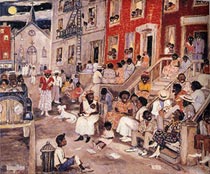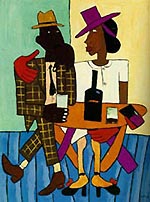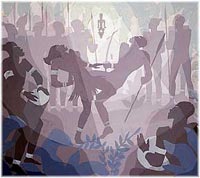| (insert your NIE or newspaper logo here) |
Weekly Online LessonOnline Lesson ArchiveGrade Level: 6-9
|
African-American Art & Identity
 February has been celebrated as Black History Month since 1976, when Negro History Week was transformed into a month-long celebration of African-American history, culture, and identity.
February has been celebrated as Black History Month since 1976, when Negro History Week was transformed into a month-long celebration of African-American history, culture, and identity.
Negro History Week was established 50 years earlier — in 1926 — by Dr. Carter G. Woodson, a noted African-American author and scholar.
Perhaps it's no coincidence that this formal recognition of African-American life cropped up in the 1920s. At the time, blacks were migrating by the masses to northern cities, which fueled a major arts movement in a New York City neighborhood called Harlem, also referred to as the "Mecca of the New Negro."
Art — in the form of musical, literary, or visual expression — often binds together a group of people who share similar ancestry, culture, religion, or other social experiences. In this week's lesson, you'll explore how this has been true for African-Americans through a variety of visual artistic styles over the years.
Colorful Expressions
 Your journey begins at the Arts & Culture: Art Focus section at the PBS site, African American World.
Your journey begins at the Arts & Culture: Art Focus section at the PBS site, African American World.
Enter the Pre-Civil War era, and read the overview. Click on the Related Artist's name, Robert Scott Duncanson. What aspects of life did his artwork typically reflect?
Move on to the next era, Exploring Freedom, and read about the Related Artists — Edmonia Lewis, Edward O. Tanner, and Laura Wheeler Waring.
How did the shifting of acceptable art styles, in general, allow for greater personal expression? In what ways did each of the related artists reflect the emotions, experiences, and identity of African-Americans?
 Now get a taste of The Harlem Renaissance. After reading the overview, learn more about Aaron Douglas, Palmer Hayden, Archibald Motley, Ellis Wilson, and Augusta Savage.
Now get a taste of The Harlem Renaissance. After reading the overview, learn more about Aaron Douglas, Palmer Hayden, Archibald Motley, Ellis Wilson, and Augusta Savage.
What was typically the subject matter of these artists, which characterized their work as being part of the Harlem Renaissance?
Then, continue uncovering The Legacy that these African-American artists, including Jacob Lawrence and Norman Lewis, created.
How did the work of these artists help other African-Americans, particularly younger artists?
During the mid-1950s through the 1970s, many black artists focused on Social Activism, including Romare Beardon, Faith Ringgold, and Elizabeth Catlett.
 In what ways did their artworks express politically-charged social statements? How are their individual artistic styles different from one another?
In what ways did their artworks express politically-charged social statements? How are their individual artistic styles different from one another?
As you'll discover in Modern Identities, the African-American art movement has moved beyond the civil rights struggles of American blacks, as illustrated by the works of Jean-Michel Basquiat and Alison Saar.
How is the focus of these two artists different from that of their African-American predecessors? How is it similar? How would you compare today's schooling, training, and exhibition opportunities for black artists to those at the turn of the twentieth century, or during the Harlem Renaissance?
Have you ever noticed any visual clues in a painting or sculpture that may reflect the artist's heritage or social experiences?
Newspaper Activities
Review current issues of Targetnewspaper to find articles about African-American artists. What type of media does the artist use? What are the subject matters the artist typically depicts? Has the artist had any type of formal training? If so, where and for how long? Does the artist seem to draw upon the styles of a particular artistic era or geographical culture?
© Copyright 2004
Learners Online, Inc.
